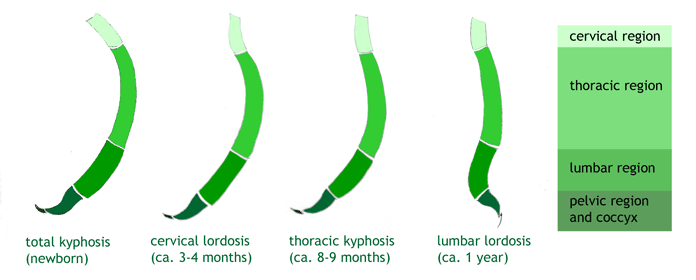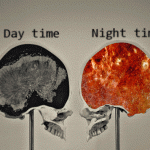
Many new parents are unsure when it comes to carrying their newborn, especially when it comes to how it may affect their baby’s development. As a Structural Chiropractor, the way I look at babywearing may be a little bit different – my focus is on how it may affect the baby’s developing spine and nervous system.
Lets start with the anatomy of a newborn. As you can see in the illustration below – the spine of an infant is c-shaped – this is natural until the baby begins to hold their head up, crawl and stand which will help develop the curves we have as adults. One of the first options parents encounter for carrying their baby is (not surprisingly) the car seat.
Research by the International Chiropractic Pediatric Association (ICPA) shows that car seats result in “restricted postural options which can impact your baby’s developing cranium and spine”. It seems that by keeping the spine in a c-shaped configuration, car seats can actually prevent and inhibit the natural curves from forming. In additon, babies can have a hard time acquiring adequate muscle strength to hold their heads up if they don’t get much of a chance to deal with gravity in an upright position. .Bottom line on car seats: an ergonomic carrier is superior to using a car seat when the baby is not in the car.
Great , so we know to use an ergonomic baby carrier – now the question is: which type? Carrying an infant upright and outward facing – where the baby faces away from the parent – (think baby bjorn) stretches the c-curved spine into a straight line, against his natural shape. In addition to stressing the baby’s spine it can also negatively influence the development of the hip joints.
Outward facing carriers (unlike, wraps, slings and mei-tais) do not provide proper leg support which can make their pelvis tilt backward and place them in a “hollow back position”. These should be avoided for young babies (under 4 months of age) because of the dangling leg posture – the hip capsule can become stretched, potentially leading to malformation of the hip joint. In addition, babies who face outwards may also not be able to shut off from stimuli and can become hyper-stimulated.
Ideally, when an infant is carried he should be facing his mother/father (chest-to-chest position). This helps to properly position the pelvis and spine, and parents can easily monitor their infant’s breathing. Ergonomic carriers put the baby in the position that supports the legs just as a mother’s arms would. The flexed abducted position is what infants naturally do when picked up – legs spread around the parent’s hip or back with knees bent in a seated position.
Before purchasing your baby carrier, I recommend doing some research online (The Baby Wearer is an excellent resource), be sure try out various brands and select one that has as much mid and low back support as possible. There are enormous neurological benefits for babies having regular small intervals of not only tummy time but also time where they are upright and being safely held in baby carriers. Both are a critical part of your baby’s neuromuscular development.
References:
http://www.babywearingadvice.co.uk/anatomy.htm
http://www.bobafamily.com/research/strollers-baby-carriers-and-infant-stress/







